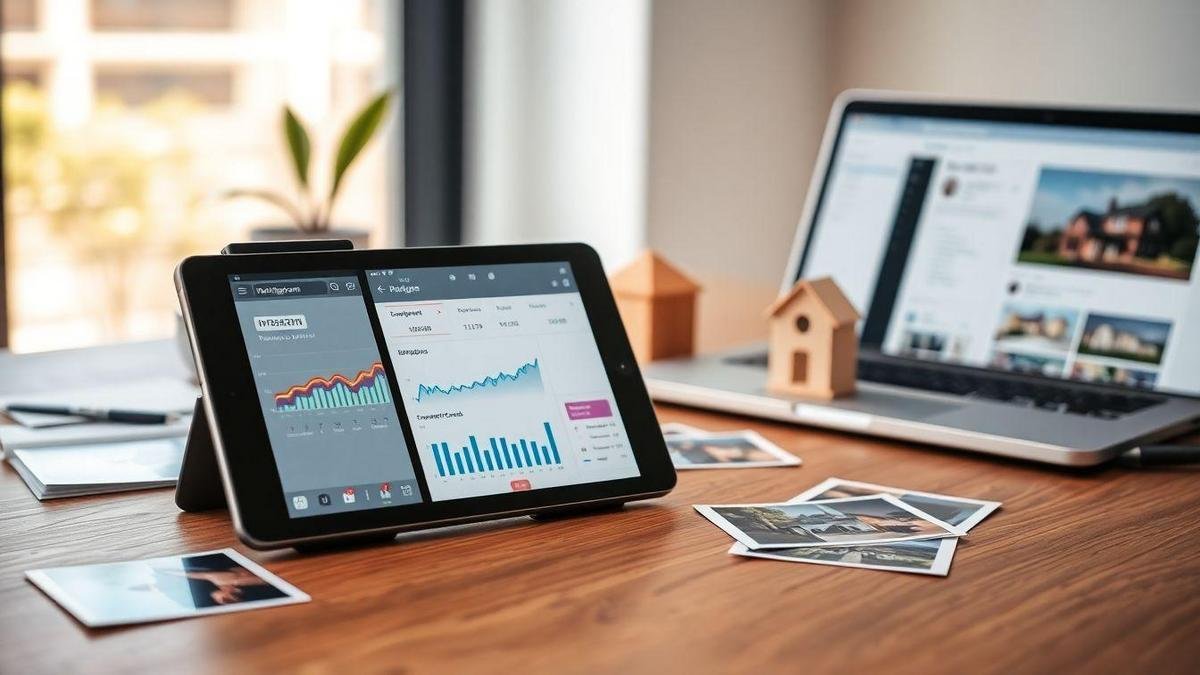Instagram marketing for real estate projects guides teams through every step of promoting property online. They learn to build a sharp profile, set a clear bio and fast contact options. It shows how to use Story Highlights and strong visuals like carousel tours, before-and-after shots, drone images and staged photos. It covers short Reels with trend tips, smart ads, local hashtags, lead capture tactics, and simple analytics to track what works. The guide ends with easy planning tips for teams, workflow and legal checks so they can plan and measure results.
Key Takeaway
- Post clear, bright property photos.
- Write short captions with key features.
- Share Reels for tours and neighborhood looks.
- Use targeted hashtags and location tags.
- Reply quickly to comments and DMs.

Instagram marketing for real estate projects: profile optimization for property listings
A real estate team treats their Instagram profile like a digital storefront. The first glance must show what they sell, where they sell it, and how to get in touch. Clear property photos, a sharp headline in the bio, and a visible contact button turn casual browsers into real leads. Short captions that show price range or unit type act like an inviting sign in the window.
Use the profile to guide visitors step by step: a bold headline, a one-line value statement, and a single strong call to action. A focused profile makes listings easier to find and faster to act on—like a good realtor at an open house pointing to the best feature. For teams building a developer-level approach, tie profile strategy into a wider social media marketing plan for real estate developers so posts and paid campaigns follow the same goals.
Analytics sharpen the approach: which posts get messages, which highlights get taps, and which link clicks lead to inquiries. Teams that check these numbers weekly can tweak the bio, link, and content order to push the hottest listings forward. Link the profile to a mobile-first landing page and measure behavior with a conversion-focused setup like the guides for website optimization for real estate leads and mobile-first real estate marketing. Small changes often bring big results when a profile reads like a helpful guide rather than a scatter of posts.
Bio and contact setup for quick inquiries
The bio must be short, clear, and action-oriented. A good formula is: Title Market Offer CTA. Example: “Sales Agent • São Paulo condos • New launches • Book a tour ⤵️” — this tells a visitor who they are, where they work, and what to do next.
Contact tools need to be visible and working. A Business Profile with call, email, and WhatsApp buttons reduces friction. Set business hours, enable quick replies, and pin a contact post so prospects can reach an agent in one or two taps. Use a CRM to manage incoming leads and automate replies—see practical setups in the CRM systems guide for real estate developers. Fast replies win trust and close deals.
Highlighting property types with Story Highlights
Story Highlights act like folders on a shelf—each one holds a different property type or status. Labels such as New Builds, 3-Bed, Luxury, or Open Houses make browsing simple. For content ideas and suggested highlight formats, combine these with the suggestions in real estate social media content ideas. Covers should be consistent and readable at small size, so a visitor can find what they need in a blink.
Order matters: place the hottest categories first, and rotate content weekly so highlights feel fresh. Include short video tours, floor plans, and pricing cards to create a mini-catalog that works like a salesperson who remembers every client’s favorite features.
Recommended Highlight categories: For Sale, New Projects, Open Houses, Neighborhood Guides
Profile photo, link and username best practices
Profile photos must be clear at thumbnail size—an agent’s headshot or a clean logo works best. The username should be simple and searchable; adding the city or niche helps (e.g., agentname_sp or cityestates). Think about discoverability and search terms similar to basic real estate SEO practices. The profile link should go to a single landing page with tracked links to listings, virtual tours, and contact forms so they can measure which posts drive real inquiries.

Instagram marketing for real estate projects: content ideas for real estate projects
Turn Instagram into a sales engine by mixing visual storytelling with clear calls to action. Short tours, floorplans, and neighborhood shots act like signposts that guide a buyer from curiosity to contact. When a post shows a bright living room or a clean floorplan, followers can picture themselves there — that mental move is where interest becomes a lead.
Treat each post as part of a narrative. A carousel might tell the story of a unit from exterior to balcony, while a Reel captures the vibe in 15 seconds. For creative prompts and post examples, pull from the content ideas collection and from proven real estate video marketing strategies. Use consistent branding, strong captions, and pinned CTAs so the profile reads like a polished brochure. Keep language simple and warm; let visuals do the heavy lifting.
Analytics matter. Track saves, shares, and DMs as much as likes. Posts that get saved show genuine intent. Over time, the team will spot patterns — which layouts sell, which neighborhoods attract inquiries — and can push budget toward the content that performs. This is practical Instagram marketing for real estate projects in action.
Carousel tours and floorplan posts
Carousels are ideal for guided tours. Start with a dramatic exterior shot, follow with key rooms, then end with the floorplan and a clear CTA. Each slide should have a single idea: light-filled kitchen, spacious master, or smart storage. Short captions on slides help viewers skim fast and still get the message.
Floorplans in a carousel add clarity and cut buyer hesitation. Overlay simple labels like “living” or “balcony” on the plan and include measurements. This reduces back-and-forth questions and raises qualified leads. Pair carousel posts with short virtual tours and three-dimensional walkthroughs recommended in the virtual tours and 3D marketing guide to improve conversion. Tag the listing and add a direction to DM for virtual tours to turn viewers into appointments.
Before-and-after and construction updates
Before-and-after posts build trust and excitement. A completed room next to the raw shell is dramatic and satisfying—people love progress. Use consistent framing so the comparison reads instantly; this creates shareable moments and boosts saves.
Construction updates humanize the project. Short captions that name a milestone — “roof complete” or “show home ready” — keep potential buyers in the loop. Time-lapse snippets or short interviews with the site manager add credibility and make followers feel part of the journey.
Content calendar templates and post frequency
A simple calendar keeps content steady and predictable. Aim for a mix: hero posts (carousels/Reels), quick updates (Stories), and engagement posts (Q&A or polls). For new projects, post 3–5 times a week and use Stories daily to capture on-site moments and FAQs. Automate scheduling and approvals where possible with real estate marketing automation tools to keep the calendar flowing.
Example weekly template:
- Monday — Project highlight carousel
- Wednesday — Reel walkthrough
- Friday — Before/after or milestone update
- Saturday — Neighborhood feature in Stories
- Sunday — Community Q&A post

Instagram marketing for real estate projects: Instagram Reels for property marketing
Instagram Reels are a powerful tool for agents and developers. For Instagram marketing for real estate projects, Reels act like a bright window on a busy street: brief, eye-catching, and inviting people to step inside. They boost visibility, reach new audiences, and let a property’s personality shine in seconds rather than paragraphs.
A good Reel tells a tiny story. Lead with a strong hook, show the flow of rooms, highlight one surprising feature, and close with a clear CTA. Short scenes, bold text overlays, and natural light help viewers feel like guests. Mixing lifestyle moments — coffee on the balcony, a dog on the floor — gives the property warmth and makes it memorable. For production and distribution tips, follow the playbook in real estate video marketing strategies that sell.
Performance matters. Track views, saves, shares, and follower growth to spot what works. Test different hooks, angles, and posting times. Cross-post Reels to Stories and tag collaborators to widen the net. Small changes in editing or sound can move a Reel from quiet to viral; treat Reels as experiments with clear goals.
Short walkthroughs that boost reach
Short walkthroughs are like movie trailers for a home. Focus on flow and feeling. Start with a 2–3 second opening that shows a striking shot — a skyline, a unique fixture, or a lush yard. Move room to room in quick beats, using text labels for key details like square footage or recent upgrades. Keep the pace lively to match how people scroll.
Production is practical and simple. Use steady movement, bright natural light, and a few staged touches — a folded towel, a plant, a set table. Aim to show the property’s story in under 30 seconds. Essential shots:
- Entrance shot
- Kitchen highlight
- Main living area
- Master suite
- Outdoor space
- Neighborhood glimpse
Pair short walkthroughs with embedded 3D tours when available to boost lead quality—see the virtual tour resources in the link above.
Trend sounds and editing tips for higher engagement
Trending audio can act like a magnet. Using a popular sound often pushes the Reel to more feeds. Pick sounds that fit the property’s mood: upbeat for modern condos, mellow for serene retreats. Match cuts to the beat so visuals and audio feel synced — that rhythm keeps eyes glued.
Editing choices make a Reel feel professional without heavy gear. Quick jump cuts, clear text overlays, and consistent color give polish. Use captions because many watch with sound off. Keep transitions simple and avoid overuse of flashy effects. A clean edit with a matching sound usually wins more saves and shares.
Ideal Reel length and caption best practices
Aim for 15–30 seconds for most property Reels; longer clips up to 60 seconds work if the story justifies it. Front-load the hook in the first 2–3 seconds. Captions should be short, offer one key fact, and end with a clear CTA like save for later or follow for more tours. Use 3–5 targeted hashtags, add a geotag, and tag partners to boost local discovery.

Instagram marketing for real estate projects: ads targeting and creative formats
Instagram is a high-impact stage for real estate projects. When a team runs Instagram marketing for real estate projects, they can reach buyers with images that stop the scroll. A well-targeted ad can put a new condo or villa in front of the right person at the right time. The platform mixes discovery with intent, so creative and targeting must work hand in hand.
Good campaigns pair clear goals with tight audience slices: location, income bands, life events like marriage, and interests such as home design. Those who define these segments will see ad relevance rise. Ads that speak directly to a neighborhood or lifestyle convert better than broad, generic pushes. For tactical setup and bidding tips, see the guide on real estate PPC advertising campaigns and tailor retargeting with the approaches in real estate retargeting strategies.
Creative must be crisp. Short videos, bright photos, and swipeable galleries help show layout, finishes, and views. Use bold captions, a clear call to action, and a quick value claim — for example, move-in ready with rooftop pool. When creative and targeting match, leads come faster and budgets stretch further.
Choosing objectives: awareness, leads, traffic
Start by picking one objective per campaign. If the goal is brand recognition in a new city, choose awareness. For agents needing contact info, pick leads. If the aim is to bring people to a property page or booking tool, choose traffic. Each objective shapes bidding, optimization, and which creative performs best. Map these objectives to your sales funnel in the real estate sales funnel guide to keep metrics consistent.
Budgets and metrics change with the objective. Awareness measures reach and frequency; leads measure form fills and cost per lead; traffic measures clicks and landing page engagement. Keep messages short and test one hook at a time to find what moves people.
- Awareness: reach many local users fast
- Leads: capture contact details with a simple form
- Traffic: drive visits to listings or virtual tours
Best ad formats: photo, video, carousel and collection
Photos work well for hero shots — a beachfront view or a bright living room. A single image with a bold headline can cut through the feed. Use clean composition, consistent lighting, and a clear CTA.
Video brings motion and emotion. Short clips — 15 seconds or less — can show a walkthrough or sunrise from the balcony. Carousel and collection formats let audiences swipe through multiple units, floor plans, or amenities. Mix formats to match the funnel: photos and videos for top-funnel interest, carousels for mid-funnel exploration, and collections for product-style browsing.
Photo | Video | Carousel | Collection
- –|—|—|—
Hero image | Walkthroughs | Multiple features | Catalog browsing
Setting budgets and bid strategies for cost per lead
To hit a target cost per lead (CPL), set a clear daily budget and choose bidding that focuses on conversions. Start with a modest daily spend, test audiences and creatives for two weeks, then scale winners. Use automated bid caps when leads are sparse, but switch to manual bidding once conversion data builds. Monitor CPL and pause low-performing sets to keep spend efficient. For deeper budget and ROI modeling, consult the real estate marketing ROI resources.

Hashtag strategy for real estate Instagram
A clear hashtag strategy helps an agent cut through the noise. For Instagram marketing for real estate projects, hashtags act like signposts. They guide the right people—buyers, renters, investors—to listings, tours, and posts. Treat hashtags as part of the message, not an afterthought.
The best approach mixes brand, local, niche, and broad tags. Brand tags build recognition. Local tags target nearby buyers. Niche tags reach specific audiences, like first-time buyers or luxury seekers. A smart blend widens reach while keeping the audience relevant. For curated lists and examples, see the best hashtags for real estate marketing.
Testing is the daily bread of good tagging. Try different mixes, track which posts drive leads, and repeat what works. Tweak one ingredient at a time and keep what performs best.
Local and niche hashtags to reach buyers
Local hashtags put a property on the town map. City names, neighborhood nicknames, and nearby landmarks attract people who search by place. Pair a hashtag with a geotag for extra local juice — one good local tag can mean a walk-in.
Examples to start:
- #CityNameHomes, #NeighborhoodLiving, #DowntownCondo, #CityOpenHouse, #SuburbNameRealEstate
Niche hashtags target the buyer profile. For family-friendly listings, use #FamilyHomes or #SchoolDistrictName. For luxury condos, lean into #LuxuryLofts or #HighEndHomes.
How many hashtags and where to place them
Instagram allows up to 30 hashtags, but more is not always better. Most pros use 5–15 relevant tags. Fewer, stronger tags beat a long, noisy list. Pick tags that drive action—searches, saves, or direct messages.
Placement matters for looks and engagement. Putting tags in the caption keeps them visible; dropping them in the first comment keeps the caption clean while remaining discoverable. Test both places and watch which brings more impressions.
Research tools and tracking hashtag performance
Tools like Instagram Insights, Later, Hashtagify, and Sprout Social help track reach, impressions, and saves from hashtags. They let an agent spot which tags bring viewers who stay, save, or click. Regularly reviewing these analytics shows what to drop and what to repeat.

Lead generation on Instagram for real estate
Agents can turn Instagram into a steady lead engine by mixing eye-catching visuals with clear calls-to-action. Short videos of model units, carousel posts that show floor plans, and Stories with stickers drive attention. Posts with a specific request — like “message for a private tour” — convert casual viewers into contacts more often than passive posts.
Successful campaigns treat each post as a small sales pitch. Add a strong value proposition in the caption and a simple next step in the bio link. For bigger projects, use Instagram to show progress updates, share resident testimonials, and run limited-time offers; this gives followers a reason to act now. Use dedicated tools from the real estate lead generation tools list to capture and qualify those contacts. Using Instagram marketing for real estate projects this way keeps the project top of mind and builds trust.
Timing and consistency matter. Teams that post at predictable times and mix content types see higher reach and more qualified leads. A weekly cadence of one listing reel, two Stories, and a carousel update creates a rhythm that followers expect and responds to.
Lead magnets, forms, and link in bio tactics
Lead magnets work like a bright lighthouse: offer floor plans, neighborhood guides, or financing checklists in exchange for an email or phone number. Keep resources useful and simple — a one-page checklist beats a long PDF. Promote the magnet in captions, Stories, and Highlights to keep it visible.
Make sign-ups painless. A short form with two fields — name and contact — removes friction. The bio link should point to a mobile-friendly landing page with a single goal: capture the lead. Combine this with email follow-ups following patterns in email marketing for real estate sales to nurture prospects into site visits.
Examples that convert quickly:
- Floor plans and price sheets
- Local market reports (1–2 pages)
- Private tour booking form
- Financing checklist or mortgage snapshot
- Early-bird offer for pre-sales
Using Instagram DM automation and quick replies
DM automation saves time and keeps prospects warm. Set up automated greetings that ask one or two qualifying questions, such as budget range or desired move-in date. That first answer tells the agent if the lead is hot, warm, or cold. Quick replies let agents handle many conversations without sounding robotic.
Use chatbots and automation thoughtfully—see practical setups in chatbots for real estate lead generation and pair them with your CRM for routing in the CRM systems guide. Automation should feel human, not canned. Include a friendly opener, a short qualification, and a clear next step — either scheduling a call or sending a brochure link. When a real person follows up within 24 hours, conversion rates jump. Tag leads by interest so the team can send targeted follow-ups later.
Measuring lead quality and conversion rates
Track metrics like lead response time, qualification rate, and tour-to-sale conversion to judge quality. A fast reply and personal follow-up often mean higher chances of sale. Compare leads from Instagram with other sources to see which campaign brings the best return—use the models in the real estate marketing ROI guide to quantify value.

Visual storytelling for real estate on Instagram
Visual storytelling turns a listing into a lived moment. Show a morning coffee on a sunlit balcony, a child racing down a hallway, or a quiet study bathed in late-afternoon light. These images do more than display features; they sell a feeling. Bold visuals and clear sequencing make Instagram posts stop the scroll and spark imagination.
Posts must follow a simple path: hook, show, invite. Open with a strong image, add close-ups that explain why the space matters, and finish with a short caption that asks a question or offers a viewing. Carousels, reels, and short clips work like chapters. A smart caption frames the scene and nudges the viewer toward the next step.
Measure what matters: saves, shares, and messages. Test post types and track which scenes trigger DMs or site clicks. Mix reels, carousel, and single-image posts to keep the feed fresh. Good visual storytelling powers Instagram marketing for real estate projects by turning browsers into leads.
Crafting a buyer-focused story arc for listings
Start with the buyer in mind. Sketch morning routines, commute ease, and weekend plans when creating content. A story arc guides that imagination: introduce the home, show daily life in key rooms, then reveal the neighborhood vibe. This makes the listing feel like the next chapter in a buyer’s life.
Practical sequence matters. Lead with the hero shot — the most emotional image — then show flow between rooms, storage, and outdoor space. Add one image of nearby parks or cafes. End with a direct CTA like book a tour or see more photos. Short captions that speak to needs convert better than long descriptions.
Using staging, lighting and drone shots to sell
Good staging clears clutter and adds cues that hint at a lifestyle: a knit throw on a sofa, a bowl of lemons in the kitchen. Lighting is the secret sauce. Natural light and warm tones make spaces feel open and inviting. Open curtains, use soft lamps, and shoot during bright, even daylight for interiors.
Drone footage gives context fast. Aerial shots show lot size, proximity to beaches or parks, and roof condition. Short drone clips at golden hour create emotion and scale—best practices are collected in the drone real estate photography guide. Use quick reels, keep clips under 15 seconds, and check local rules for flight. Bold, sweeping views help buyers see both the house and its story.
Brand voice and consistent visual templates
A consistent feed builds trust. Pick a simple palette, two filters, one font for overlays, and a fixed logo spot. The brand voice stays steady: professional, warm, and helpful. Templates for hero shots, interiors, and neighborhood posts speed production and keep the feed recognizable. For broader content planning aligned to investor messaging, review content marketing for real estate investors.

Instagram analytics for real estate marketing
Treat Instagram like a fingerprint for a project: every like, comment and save leaves a mark. By tracking Instagram analytics you see which posts draw a crowd and which scroll past. Short videos that show a pool at sunset might get high views, but a carousel with floor plans can bring saves — both valuable in different ways.
Analytics turns feelings into facts. A spike in reach means a post found new eyes. A growing number of saves signals real interest in the asset. Read those signals and shift budget, content type, or targeting. That quick read-and-act loop keeps campaigns from drifting. Combine these insights with predictive models when scaling—see predictive analytics in real estate marketing for ways to forecast results.
Good analytics keeps the sales pipe full and honest. Compare post-level performance to lead form fills and show rates. When numbers match stories — more saves, more inquiries — the strategy earns its keep. If not, tweak imagery or copy and test again.
Key metrics: impressions, saves, shares, reach
Impressions show how often a post appears. High impressions with low actions means the creative is being seen but not felt — consider better staging, clearer captions, or a stronger CTA.
Saves and shares are gold. A save often means a prospect wants to return. A share spreads trust; neighbors can become brand ambassadors. Reach reveals audience breadth: a small, consistent reach with high saves beats a wide reach with no interest for niche projects.
A/B testing posts and ad creatives
A/B tests are small experiments that answer one question at a time. Test image A vs image B, headline X vs headline Y, or a short reel versus a walkthrough. Change one thing, measure the lift, and pick the winner.
Keep tests short and strict. Run each variant long enough to collect meaningful clicks and saves, then pause the loser. Over time this builds a library of what resonates — the right angle for young buyers, the right lens for luxury units, the best CTA for tours. For retargeting and iterative testing with AI support, see retargeting campaigns with AI.
Reporting cadence and KPIs for developers
Developers get weekly snapshots for operations, monthly trend reports for marketing strategy, and quarterly ROI reviews for budget decisions. Key KPIs are leads, cost per lead, conversion rate, show-rate, and sales velocity—reported with context so numbers tell a story, not just sit in a spreadsheet. Tie reports into your ROI model and forecasting approach in the ROI guide.

Instagram strategy for property developers: planning, budget and compliance
A strong Instagram plan starts with clear goals and a simple map of actions. The developer decides what success looks like — more leads, faster presales, or stronger brand recall — and then breaks that into weekly content themes and ad campaigns. When applied to Instagram marketing for real estate projects, this plan ties posts, reels and ads directly to measurable outcomes like visits, inquiries and bookings. Short, repeatable cycles help the team learn fast and cut through the noise.
Content and creative must match the sales funnel at each stage. Early posts show lifestyle and location with crisp photos and short reels; mid-funnel content dives into floorplans, pricing and virtual tours; bottom-funnel assets push limited offers and CTAs. Track one or two key metrics per campaign — impressions for awareness, clicks for interest, and conversions for sales — and prune what underperforms. This keeps the calendar tight and the budget honest.
Compliance and legal checks belong in the plan from day one. Flag permit needs, truth-in-advertising rules, and HOA or municipal restrictions before a campaign goes live. Fold approvals into the timeline so creative can move forward without surprise stops.
Setting goals, audience personas and timelines
Goals must be written and specific. Write goals like: increase qualified leads by 30% in three months or sell 20 units before launch. These targets give the social team a north star and make reporting simple. One clear metric per goal keeps attention on what matters and avoids busywork.
Personas turn targets into people. Sketch profiles: young families seeking schools, remote workers wanting space, investors hunting yield. For each persona note pain points, favorite content formats, and best posting times. Examples help: a young couple prefers reels showing morning routines, while an investor reads carousel posts with cap rate estimates. Use the sales-funnel framing in the sales funnel guide when building timelines.
Typical campaign goals and personas:
- Awareness: locals, commuters, culture seekers
- Interest: families, professionals, empty-nesters
- Decision: investors, relocators, end-buyers
- Timeline phases: Teaser (2–4 weeks), Launch (1 week), Sales push (4–12 weeks)
Team roles, workflow and agency collaboration
A compact team speeds decisions. Assign a content lead, a paid-ads specialist, a community manager and a compliance reviewer. Each role has a single owner to prevent overlap. The content lead owns the calendar; the paid specialist owns budgets and targeting; the community manager answers DMs and flags leads; the reviewer signs off on legal copy.
When working with agencies, the brief must be sharp. Share goals, persona sheets and brand rules upfront. Weekly check-ins keep the campaign nimble. The best collaborations feel like a relay race: the in-house team passes the baton to the agency for production, then takes it back for local execution and sales follow-up. Use automation and CRM integrations described in the marketing automation tools guide and the CRM systems guide to remove friction between teams.
Budget allocation, ROI models and legal compliance
Budget divides into three buckets: content production, ad spend, and compliance/legal. A simple ROI model links spend to leads and to expected sales value per lead so the developer can forecast payback. Legal checks are budgeted as a line item to review copy, contracts and ad creatives before launch, preventing fines and costly edits.
Conclusion
Treat Instagram as a digital storefront and a sales engine. Clear profiles, bold bios, and fast contact options form the front door. Strong visuals — carousels, Reels, drone shots, and staged photos — act like signposts that guide a buyer from curiosity to contact.
Tactics matter and so does sequence. Use Story Highlights, targeted hashtags, pinned CTAs, and quick DM flows to capture interest. Short captions, consistent branding, and trend-aware Reels pull attention. Automation and quick replies keep leads warm without sounding robotic.
Measurement keeps the strategy honest. Weekly analytics checks, A/B tests, and defined KPIs (leads, CPL, show-rate) turn instincts into data. Planning, defined team roles, budget lines for ad spend and legal compliance, and a repeatable content calendar stop surprises and speed execution.
In short: plan the map, tell the story, measure the path, and iterate. Small, consistent changes often deliver big results. For more practical guides and examples, readers are invited to explore additional articles at https://realhubly.com.
Quick checklist: Instagram marketing for real estate projects
- Optimize profile: clear headline, market, CTA, contact buttons.
- Use Highlights: New Projects, For Sale, Open Houses, Neighborhoods.
- Content mix: 2–3 Reels/week, 1–2 carousels, daily Stories.
- Hashtags: 5–15 mix of brand, local, niche, and broad — see best hashtag examples.
- Ads: test one objective per campaign (Awareness, Leads, Traffic) and review PPC campaign tactics.
- Lead capture: one-page magnets two-field forms—pair with lead generation tools.
- Respond: automated DM qualifier human follow-up within 24 hours; see chatbot tips.
- Measure weekly: impressions, saves, shares, reach, CPL, show-rate; benchmark using the ROI guide.

No responses yet